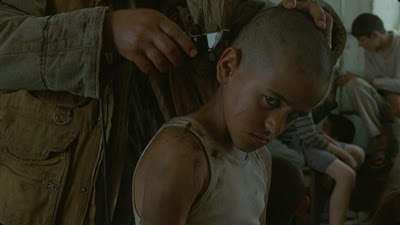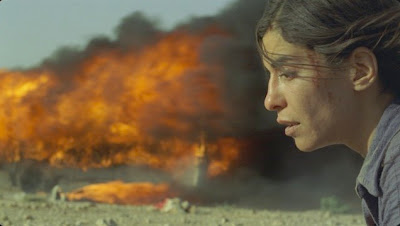This cross-post by Vicky Moufawad-Paul appears as part of our theme week on Child and Teenage Girl Protagonists.
Every once in a while a role comes along for a young woman who is at that tough age–that age that makes her adult-like, but before she’s realized the limiting effects of the male gaze. She is smart enough to know what is right and young enough to not know that the world doesn’t work according to right and wrong. She speaks truth to power, and expects power to accede to what would be justice. She sees what is incongruous and expects that if she shows it to others, they will correct their ways. If they don’t correct their ways, she is old enough, and in her own power enough to be able to resist their attempts to make her follow their ways. She is interested in freedom and is often called willful, clever, argumentative. It is a window that, for most women, opens as puberty hits and then shuts as puberty ends. For many women, the social relations of feudalism and capitalism make us bend and transform under patriarchal control.
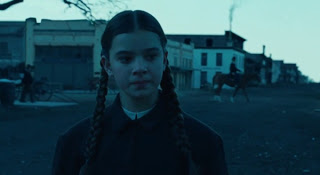
Independence, Over-Sized Clothes, and Olden Times
I recently saw True Grit, and although I don’t usually enjoy Coen brothers films, I did enjoy this film. Let me get it out of the way: I don’t connect with most of the Coen brothers’ films and I was flabbergast when a few men in my Film Studies classes during my master’s programme listed Barton Fink as one of their top ten films of all time. At the risk of sounding essentialist, in my mind the Coen brothers make “guy” films–films that guys love, but women rarely rave about. Enter: True Grit. Or, more accurately, enter the star of the film, Mattie Ross, a 14-year-old girl played by a feisty 14-year-old mixed-race Hailee Steinfeld.
Not since Megan Follows played Anne of Green Gables in the 1985 adaptation of the novel with the same title have girls had a young protagonist on screen who fights against social conventions that are designed to limit her because of her age and gender. Mattie’s similarity to Anne doesn’t end at their indignation and fearlessness, they both also share a love of long braids, both can be found wearing ill-fitting clothes, both of their stories are set in a similar time period, and finally, both girls are orphans.

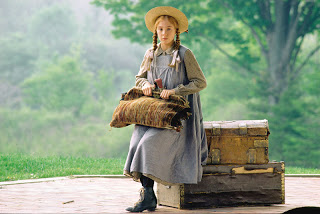
Although Mattie’s mom is still around, her father has recently been murdered, and thus she has to fend for herself in situations that her father ordinarily would. Instead she is settling her father’s business affairs and searching for his killer. A whip-smart character scene shows Mattie negotiating the selling and buying of her father’s property with an adult male horse dealer. She uses fast-talking, stubbornness, sharp instincts, and the occasional appeal to getting a lawyer involved to keep her from getting taken advantage of, and in fact, gets what she wants.
Mattie shows that she can cross a river on horseback, climb trees, cut a dead hanging man down, and most importantly, keep her mouth shut when appropriate. She’s the sidekick who runs the show. Even when her interests don’t dovetail with those she has hired, she re-convinces them that their interests do coincide.
Cowboy films, as a genre, are not only male-dominated, but they also have troubling relationships to Aboriginal peoples. Critiques of the implicit and explicit issues with representation of First Peoples by Hollywood has been amply put forward elsewhere, notably by film critic Jesse Wente. I wonder what the Coen brothers were thinking when they included two scenes with Aboriginal people in them. The first seems to be a critique of racism: an Aboriginal man is hanged without being allowed to say his last words, unlike the white men being hanged beside him. I applaud this implicit critique of the differential treatment of criminals of different racial backgrounds.
The second depiction of frontier relations with Aboriginal people is a scene about halfway into the film, when the character Rooster, played by Jeff Bridges, kicks two First Nations youth. This unmotivated violence could have been another critique of racial violence (simply by making it visible), if it were not for unfortunate editing choices. Rooster is climbing the porch stairs of a house he wants to enter. There are two First Nations boys sitting on the edge of the porch of the house. Out of nowhere, Rooster kicks one of the boys and he falls off the porch onto the ground. The camera focuses on the facial reaction of the other boy who is still sitting. He laughs. Seconds later the boy who laughed meets the same fate. In the theater when I watched the film, the first reaction shot established the tone for the audience reaction to the action when it was repeated. The senseless abuse of native children by an old white man got the biggest laugh of the film. And it’s worth noting that this is one of the only laughs in a film that is mostly stern and quick.
I also have to express disappointment in the choices made around the casting and direction of the adult Mattie. I would have hoped that the young fearless girl would grow up to be someone who could have been played by Michelle Rodriguez.
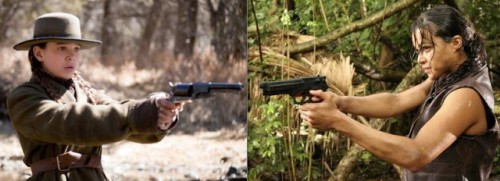
Elizabeth Marvel, who was cast to play the adult Mattie, embodies a conventionally strong womanliness, that is more like the unhappy stern and uptight spinster, Marilla Cuthbert, who adopts Anne in Anne of Green Gables.

As I’ve mentioned, I usually have a “ho-hum” attitude toward Coen brothers films and toward cowboy genre films. But True Grit is saved by a fierce tween. Maybe the Coen brothers should cast Willow Smith in their next film? Based on how a tween rocked their script, I’d love to see them give ten-year-old Willow a chance to whip her hair on the silver screen.

Willow already wears braids, so she’s half way there. I’d ask the Coen brothers to give Anne of Green Gables a watch first, though. Come on, even in 1985 they let a girl have a little roll in the hay with her bosom friend.

Are Anne and Diana just bosoms? Or is the roll in the hay a vital part of their youthful strength?
Vicky Moufawad-Paul is a curator, artist, film programmer, and the artistic director at A Space Gallery in Toronto. She earned a Masters of Fine Arts from York University, where she conducted research on the visual culture of Palestine. She was previously the founding executive director of the Toronto Arab Film Festival, and has worked at the Toronto International Film Festival Group. She was a member of the Visual and Media Arts Committee at the Toronto Arts Council, a founding member of the Advisory Board of the Palestine Film Festival, and a member of the Board of Directors at Trinity Square Video. Her writing has been published by Fuse Magazine, E-Fagia, the Arab American National Museum, and the Journal of Peace Research. She was also a contributor to the anthology Decentre: concerning artist-run culture/a propos de centres d’artistes (YYZ Books, 2008). Moufawad-Paul’s video art has been exhibited nationally and internationally.
